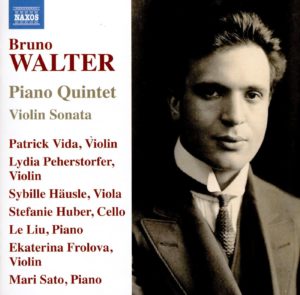Like many conductors of his era, Bruno Walter (1876-1962) tried his hand at composing. Most of his creative work dates from early in his career, during his years as Mahler’s protégé. Although Walter ultimately gave up writing music to focus on his conducting career, the two large-scale chamber works offered here reveal a young composer full of confidence and skill, with a flair for inner drama.
To be sure, Walter’s style was more derivative than original, and he was not the most memorable melodist in the world. Yet his three-movement 1908 Violin Sonata holds interest through its wide dynamic contrasts and full-bodied yet never cluttered violin/piano interplay. Brahms’ contrapuntal rigor often comes to mind, but so does Franck’s restless chromaticism and Strauss’ declamatory gestures.
To sell this music, however, one needs committed performers. Happily, violinist Ekaterina Frolova and pianist Mari Sato revel in the outer movements’ sweeping climaxes, but also imbue the central slow movement’s starkly lit phrases and telling silences with nuanced drama. What is more, their interpretation has a fervency and forward impetus lacking in the relatively sedate Philippe Graffin and Pascal Devoyon traversal on Hyperion.
So far as I know, the 1904 Piano Quintet receives its first recording here. Admittedly, the dense and propulsive outer movements flounder all over the place. Walter tosses out ideas like darts that don’t consistently strike nor stick to their intended target. But the second movement marked “Ruhig und heiter” has a melodious sweetness that Mendelssohn would have appreciated, albeit with fewer notes and more transparent textures.
Similarly, one could describe the triple-meter third movement (Geheimnisvoll bewegt) as a slithery Mahler Scherzo that probably would take wing if not for overly busy string writing that’s little more than background noodling. One could imagine more gravitas to the massed tuttis and more tonal focus in the high string writing, yet the performers (violinists Patrick Vida and Lydia Peherstorfer, violist Sybille Häusle, cellist Stefanie Huber, and pianist Le Liu) clearly have mastered this score from top to bottom.
It’s good to have these fascinating works coupled, together with Naxos’ excellent annotations and robust sonics. But if you want to sample the wild side of Bruno Walter’s creativity at full tilt, his wonderfully discombobulated Symphony No. 1 is the place to start.
































